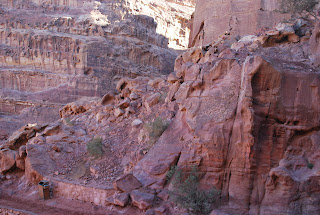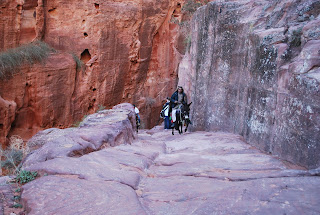Saturday, March 31, 2012
Madaba, Jordan
Though it was sttled since Nabataean times, its most important days was when it was an important Byzantine city. Byzantine churches abound and even till today about 15 Byzantine churches exists in Madaba. During Byzantine times it was renown for its mosaics, it is also called 'the city of mosaics. The most important piece of mosaic was found on the floor of St George church.
Friday, March 30, 2012
more bedouins
On the way down we met some bedouin children. Their family run this ramshackle souvenir store. The official word is they go to school. I don't think so but as they grow up they pick up languages from the tourists. Most of them speak incredible English.
Thursday, March 29, 2012
Continuing downwards
I'm still amazed that we didn't get lost. The signage was poor and the steps cut into the rock were shallow in some places. In other places it was quite impassable because of debri. But we made it down. This was actually the way up in the olden days as pilgrims climb to the high place of sacrifice. What a beautiful and amazing place, Petra is. I'm so glad I came.
Wednesday, March 28, 2012
the colored triclinium
There's more to see as we ventured down from the high place of sacrifice. This was our last few hours in Petra. We were almost at the bottom of the valley and soon would be returning to the entrance. The trip was indescrible, seeing pictures of Petra all these years and then finally to set foot in it is surreal. What can I say? But onward and forward...there are other places to be explored.
Tuesday, March 27, 2012
the soldier tomb
Tomb of the Roman soldier.... just across from the garden tomb. It has three niches that house the figures of three Roman soldiers. We didn't go inside but I read that the whole interior has been blackened by the soot of fires lit by bedouins seeking shelter, an unintended consequence.
Monday, March 26, 2012
Sunday, March 25, 2012
a bedouin woman
I think she is deaf. I was hovering behind her for the longest time but she didn't even turn around to acknowledge me. I was making noises as I took pictures and calling for Sophie to come and meet her. I don't know if she could see very well. It took her quite a bit of time before she realised that we were there. At which time she got up from what she was doing which was lighting a fire to make tea, to show us the postcards and trinkets she had for sale. As usual, Sophie, being the bleeding heart that she is, stopped to buy some postcards.
Saturday, March 24, 2012
the lion fountain
Time and weather has done a number on this lion carving. It was reported it had a metal head. There are channels that drove the water into the fountain but they are all gone. The way we took to get down from the high place of sacrifice is also called the 'way of pilgrims.' Actually it was the way for pilgrims to get up to the high place of sacrifice. The lion fountain is half way up and the thirsty pilgrims would stop here to quench their thirst. Also it was used as a place to clean up before getting to the high place of sacrifice.
Friday, March 23, 2012
the other way down
The other way down was beautiful and wild and scary. Even though there were steps cut out in the rock, they were quite faint and there wasn't any way marking at all and we weren't sure about they way. But we did make it down and back to the entrance. It was our last hour, we were to return to our hotel, check out and go to the bus station to take the JETT bus back to Amman.
Thursday, March 22, 2012
the high place of sacrifice
In the early days, around the second century, they do sacrifice humans here. It was reported that once a year a young boy's throat is slit here and his life bloond offered to the Nabataen god. Besides this there were regular animal sacrifices. Here were found raised altars and drainage for the flow of blood. It is a huge complex and I can imagine in its hey days, the gathering of priests and worshippers for each sacrificial ceremony whether of human or animals. Anyway the clim up here was exhausting. We could have gone down the same way but we didn't. Instead we chose to go down the back way.
Wednesday, March 21, 2012
We are almost there
It was a hard slog getting up there. The younger visitors were passing us and we could see this tiny figure up there ahead of us. It was s terrific day for that climb. That was our last day.
Tuesday, March 20, 2012
Another bedouin family
On the way up I came upon this Bedouin family having breakfast. This beautiful girl greeted me, offered me this huge chunk of homemade bread that her mother had just baked in that rudimentary fire that they call 'kitchen'. I protested, I couldn't in all clear conscience take their meager victuals, I ate a small piece and handed the chunk back to her. I said, 'I just had a big breakfast at our hotel'. I did share a cup (or glass) of her tea. I took her picture, a beautiful girl, she didn't show her teeth because some of her front teeth were missing. The Bedouins we met in Jordan has touched our heart so much. They contributed to the stories I brought back from this trip. It's not places but people also that add that extra element to all my trips.
Monday, March 19, 2012
Another climb
The climb to the high place of sacrifice, though not as long as the climb to the monastery, was just as steep. It took us quite a while to climb up on our own two legs. We had to stop every few steps to catch our breath. But we passed some incredibly beautiful views. There were others climbing up with us, so we were never alone. One is never alone even though the place looked empty and desolate. Bedouin families are encamped at various strategic places everywhere and there are lots of encounters with them. They depend on the tourist trade for their livelihood.
Sunday, March 18, 2012
the arched gate
At the end of the colonnaded street is this massive gate, partly destroyed by earthquakes. It had originally three arches and once formed the entrance to a Nabataean temple. Its beautiful friezes can still be seen on what is still standing. Today bedouins trek through this place with their camels hauling tired tourists. It was once a sacred place.
Subscribe to:
Posts (Atom)























































